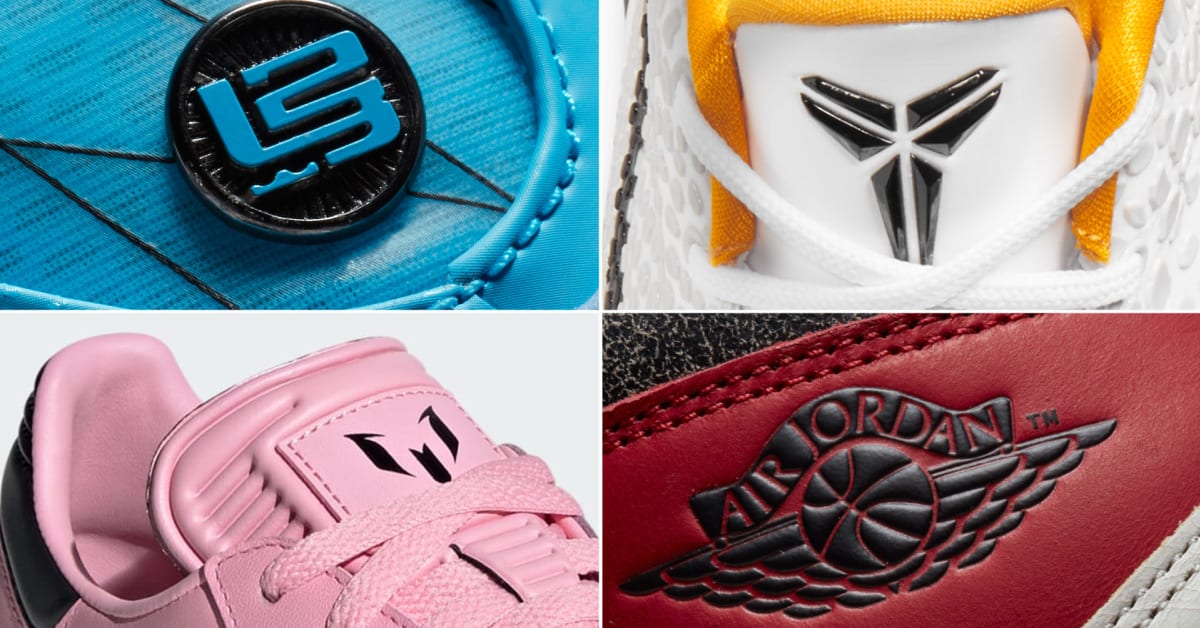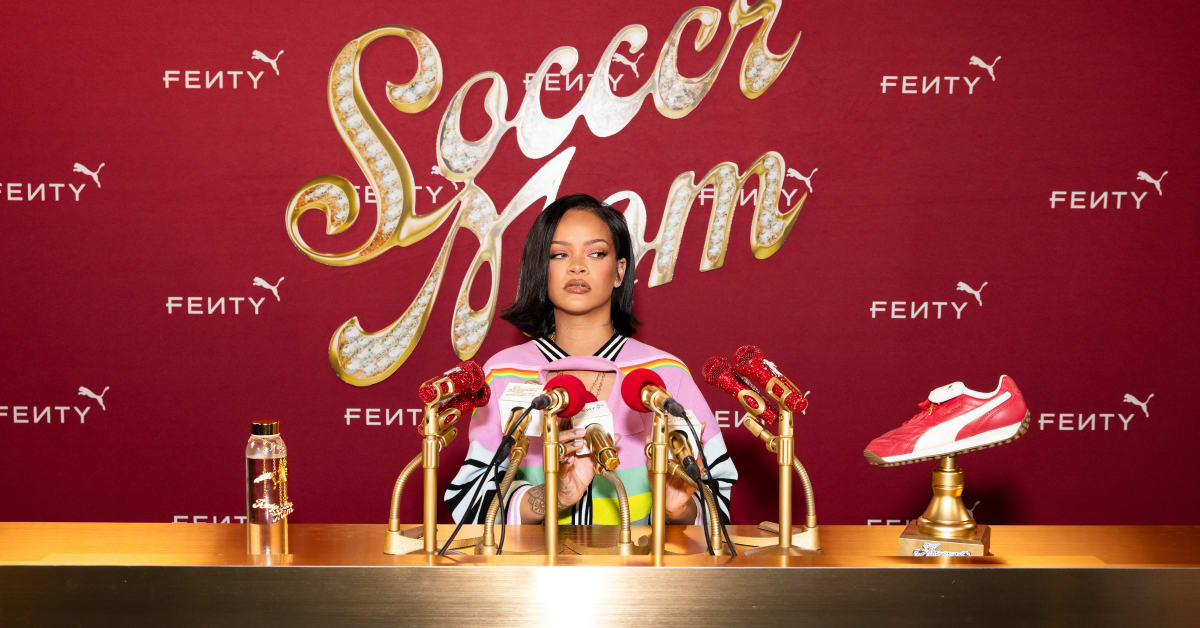Can an athlete logo contain multitudes? Can a monochromatic mark somehow capture all the glory of a basketball player’s achievements or the verve of a charismatic tennis star? That’s a gigantic ask on its own, but in the right context—embedded on a powerful sneaker or a piece of gear that played a part in a crucial sporting moment—athlete signature logos can communicate the depth of their muses. They are a critical element for classic sportswear; if you want to cement a shoe’s status in history, you need to give people a simple, recognizable icon, not a complicated technological doohickey for their feet. What are the best signature athlete logos? We combed through brands and players, sticking strictly to logos associated with sneaker companies, to pick the ones we feel are the most impactful. In ranking them, we placed a decent amount of weight on just how big or long-lasting the shoes they’re associated with have been, because a good logo can’t be great if it never landed on a meaningful product. These are the best athlete signature logos of all time.
Kevin Durant is a no-frills kind of player—no flashy tunnel outfits, just basketball. Aside from his tendency to engage in social media spats, he’s kept a low profile even while in dramatic situations, like his championship run with the Warriors, or the hornets nest swirling around him in Brooklyn. It’s fitting that his logo also get right to business, which is exactly what the stylized “KD” does. Its best use, perhaps, was on the tongue of the Nike KD 3, where the middle of the “D” was cut out and served as a pull-tab. —Zac Dubasik
Nike Air Max Sensation. Via Nice Kicks
Chris Webber was a Nike guy—one of the most important Nike guys—until he wasn’t a Nike guy. His days with Michigan and the Fab Five changed the way people looked at basketball style. So it only made sense that Nike gave him a signature shoe. His shoe, the Air Max CW, fit in line with ‘90s basketball shoes, big bubbles and all. And the logo on the heel was a ball going into a hoop, but it spelled out CW. Nike would re-release the shoes in 2007 under the name Air Max Sensation, as Webber was gone from Nike at that point. Not only did the retro not have his name on it, it also was missing his logo. Safe to say it didn’t hit the same. —Matt Welty
Serena Williams x Nike Victory Tech. Via Nike
We forgive you if you needed a reminder of what Serena Williams’ Nike logo looked like. It’s not been super salient in her apparel and footwear. And while it’s not that recognizable or well imprinted into the memories of sneaker people, it’s a smooth, rolling insignia based on her initials that does a fine job capturing her grace. —Brendan Dunne
Adidas Samba. Via Adidas
Leo Messi and Adidas are linked together as much as any athlete and brand in professional sports. So it makes perfect sense that the GOAT’s logo contains three stripes weaved into it. The stripes use negative space to create an “M” in a striking way that matches the playstyle of the shifty winger. —Ben Felderstein
Nike CJ81 Trainer Max. Via Social Status
We’re sure that a lot of you either don’t remember or never knew that Calvin Johnson had his own signature Nike logo. Like the standout wide receiver’s career, the run of his logo was far shorter than it should have been (many consider Johnson to be the most talented receiver ever, but he only played nine seasons). Alluding to his nickname “Megatron,” the Hall of Famer’s logo is directly inspired by the Decepticon, replacing the details of the robotic villain’s face with Johnson’s initials. Megatron (the NFL player) never really had a significant run of signature footwear, but we’re not here to talk about that. Regardless, he did have one of the more unique signature logos the Swoosh ever put together. —Ben Felderstein
Adidas TMac 2. Via Ebay
Anytime you can look at a signature logo and know exactly what sport the person plays without knowing anything about the person, you’re off to a good start. That’s exactly the case with Tracy McGrady’s signature Adidas logo. It expertly combines the star guard’s initials, with the “T” creating a rim and the “M” representing netting on a basketball hoop. Equally important, this logo looks like it perfectly belongs on any sneaker it found itself on. —Ben Felderstein
The use of a jersey number in a logo or nickname is always a risky move, but it’s one that’s worked out for Chris Paul, who’s worn the same no. 3 for his entire career. The symbol was created by longtime Jordan Brand designer Justin Taylor, who worked on most of Paul’s signature models. It perfectly links his initials, with the 3 revealing itself in the negative space. Paul, who’s referred to as “CP3” almost as often as his actual name, even got an assist from his new Spurs teammate Kelton Johnson, who switched to no. 0 this season to allow him to keep the streak alive. —Zac Dubasik
Nike Air Force 1 ‘Sheed.’ Via Getty
Rasheed Wallace technically never had a signature sneaker. But he made the Air Force 1 his shoe. The shoe first came out in 1982 and was a serious sneaker in the early ‘80s in the NBA, worn by legends like Moses Malone and Michael Cooper. But it was dead in the ‘90s and 2000s, as far as performance basketball went. Not to Rasheed Wallace. Nike made player exclusives for him that included the silhouette of him shooting on the heel. Pairs for his tenures in Detroit and Portland are true grails to sneaker collectors. Wallace’s jumpshot silhouette harkens back to the days of old school hoopers. It’s only fitting it was put on an Air Force 1. He was known for wearing the high tops with the strap dangling off the back. —Matt Welty
Adidas Mutombo. Via Foot Locker
First thing’s first, rest in peace Dikembe Mutombo. There’s something perfectly 1990s about the logo that adorned his Adidas gear. The line leaned into his Congolese background with a jumbo shield icon to denote the protection and defense Mutombo brought to the court. Don’t forget that his Adidas deal involved a couple of other industry legends on the brand side—Sonny Vaccaro and Peter Moore were also involved. —Brendan Dunne
Nike Tiger Woods ’13. Via Nike
Woods started out at Nike in the ’90s with a different logo, and made the switch to his iconic “TW” mark in the 2000s. But you won’t be seeing that logo anytime soon; Nike and Tiger Woods are over, and the golf legend doesn’t have access to the mark anymore. “I don’t want it back,” he said this year while promoting his new line, Sun Day Red. “I’ve moved on.” Nike and Woods had a long partnership that resulted in more memorable ads than it did memorable footwear, although the TW ‘13 is still one of the coolest golf shoes ever. —Brendan Dunne
Nike Air Zoom Vapor X. Via Getty
There’s nothing that splashy or clever about Roger Federer’s logo, and that’s totally alright. His brand mark, which appeared on his tennis sneakers at Nike, is a pretty plain one, made elegant and unique by the subtraction of a couple vertical lines. By the way, we’re considering Federer a signature athlete from his time at Nike because the Vapor Tour line was his de facto sig, even if it did not bear his name. The Swiss great stands out on this list as his logo exists outside the bounds of his biggest sneaker endorsement—Federer’s RF mark was designed by his wife before it ever appeared on his Nikes. It’s most associated with his Nike product, but it belongs to him now; Federer left Nike in 2018 and secured the rights to the mark after a legal battle with the brand. —Brendan Dunne
Nike Air Pippen. Via Stadium Goods
Scottie Pippen’s most memorable sneaker wasn’t even his sneaker. The Air More Uptempo, worn by Pippen, is what most people think of when you say, “Scottie Pippen sneakers.” But Pippen didn’t get his own signature shoe until the following season with the Air Pippen 1. And that’s a great shoe, too, even if Pippen didn’t like wearing the retail version with the full-length Air Max unit. It was also his first shoe with his logo: two Ps with a basketball shooting through the middle. It almost looks like a microphone. And it reads “Pip.” Former Nike designer Aaron Cooper has shared a bunch of drafts for Pippen’s logo. Many used a similar concept, but some spelled out Pippen. Safe to say, the final version was the best. Nike even went back retroactively and put Pippen’s logo on the Air More Uptempo in 2017. —Matt Welty
Reebok Answer 1. Via Ebay
Encapsulating everything that makes Allen Iverson so cool and distilling it down to a black-and-white mark is a nearly impossible task. Iverson at the peak of his powers had way more aura than could ever be contained in a logo. His I3 mark did a decent job of it though, creating an identity for AI within Reebok and a logo to go with it. (We’ll admit the logo loses some points on context, as it wasn’t around yet for the Question, his first signature shoe). It conveys his quick cutting style and adorns some of the better non-Nike basketball shoes of the late ’90s. —Brendan Dunne
Nike Lunar Ballistec. Via Nike
Mess with the bull, get the horns. Rafael Nadal has won 22 Grand Slams. He’s the master of clay courts. Playing off his on-court style and Spanish heritage, Nike made his logo a bull’s horns. Nadal never technically had a signature at Nike, but he’s had plenty of shoes with his logo on the tongue. And it just looks cool. Just look at the Zoom Vapor Cage 4 in the Rafa edition. Awesome. —Matt Welty
Nike Air DT Max 96. Via DTLR
Deion Sanders is one of the most impressive professional athletes of all time. He is one of only three people to ever play professionally in both the NFL and the MLB, along with Bo Jackson and Brian Jordan. What separates Prime from the other two is the fact that he played baseball and football on the same day twice; once in 1987 for Florida State University, and once in 1992 for the Atlanta Falcons and Braves. When designing Sander’s signature logo, Nike decided to highlight both of his sports, having a football goal post sticking out of a baseball home plate, the perfect homage to a true sports unicorn. —Ben Felderstein
Nike Air Max LeBron 7. Via Nike
The integration of one’s initials and jersey number is a natural starting point for a logo. The caveat to this formula is that over the course of a career, a player’s number can change multiple times, rendering it unusable. LeBron James wore 23 for his first run with the Cavs, 6 with the Heat, 23 for his second Cavs stint, 23 initially with the Lakers, then 6, then back to 23. The majority of that time he’s used a stylized “LJ” crown symbol, which is a totally fine logo and would have probably made this list on its own, had that been James’ only insignia. His original “L23” logo, however, on which the second variation was based, is the more enduring mark. It was part of our introduction to the most hyped player of the era, framed perfectly in the middle of the tongue on his debut signature shoe, the Air Zoom Generation. —Zac Dubasik
Adidas D Rose 5. Via Adidas
You’d be foolish to design a logo for a guy with a name as good as Derrick Rose and not just use what’s right there for the taking. Adidas made the correct call with Rose, creating for him a clean representation of his D-Rose nickname. It goes deeper than that in the details—the subtle no. 1 at the center of it representing his jersey number and his mother, the three petals representing his brothers—while still reading well at surface level. Rose’s logo is a bit of a tough one to rank because it’s not affixed to any classic or really memorable sneakers, but is still one of the more thoughtful athlete marks out there. —Brendan Dunne
Reebok Shaq Attaq 4. Via Stadium Goods
There’s the Jumpman and then there’s the Dunkman. Shaquille O’Neal’s logo, which began with Reebok in 1992, is a silhouette of the 7’1 big man dunking, knees raised to his chest. The logo first appeared on O’Neal’s debut shoe with Reebok, the Shaq Attaq. The shoe itself was a bold statement by the brand—white and blue with a Pump on the tongue and Shaq’s logo on the heel. Shaq’s dunking lore was a thing of legend. All I remember as a young kid was him breaking backboards in that era. I had the Shaq toys of him dunking. Seeing him doing it on a shoe that looked literally larger than life was just the icing on the cake. The logo still lived on even after Shaq left Reebok for the first time, and was included on his Shaq sneakers that were sold at Wal-Mart. —Matt Welty
Nike Griffey 2 MCS. Via Nike
It makes perfect sense that the sweetest swing in the history of baseball would lend itself to the best signature logo in baseball history as well. Like many logos on this list, people are going to say that it is derivative of the original Jumpman, as at the end of the day it is just a black silhouette of Griffey in one of his most iconic poses. That’s one of the reasons why it isn’t towards the very top of this list, but for my money it’s one of the most aesthetically pleasing signature logos you’re ever going to find. — Ben Felderstein
Look, the important thing is that the Kobe logo is still getting used. Nike is fully invested in posthumous Kobe Bryant sneaker releases, and his widow, Vanessa, is on board. The sneaker company is scaling Kobe retros to meet demand—Nike said in an earnings call this month that it quadrupled its Kobe business in the last year. Bryant’s logo is one of the more abstract ones, a geometric design known as the “sheath” that eschews traditional player logo inclusions like initials and numbers. The geometry gives it balance and symmetry that most sneaker logos lack. There’s something stoic and calculated about it, like the man it’s meant to represent. —Brendan Dunne
There is no Jumpman without Wings. It could probably also be argued that there’s no Jumpman without New Balance, but that’s a discussion for another logo. The point is that without the relative success of the early Air Jordan models, and the Wings logo that adorned them, the Air Jordan line may have never turned into the force it is today. The Wings emblem debuted on the collar of the Air Jordan 1, taking a secondary role to the primary Nike Swoosh. The Air Jordan 2, however, lost the Swoosh, allowing the Wings logo to stand on its own. It’s been used on many more pieces of apparel than shoes over the years, but its status in the history of the Air Jordan line, and sneakers in general, is iconic. —Zac Dubasik
Nike Air Penny 1. Via Nike
Get it? It’s the cent symbol, like a Penny. There aren’t many signature basketball lines that are better than Penny Hardaway’s, especially if we’re lumping the Foamposites (which used his logo) in there. His is one of those super obvious emblems for an athlete that proves sometimes you don’t have to overthink it. No twisting maze of interlocked initials, no too literal likeness, just a simple symbol that immediately communicates the idea. In other words, it just makes sense (cents?). —Brendan Dunne
Adidas Stan Smith. Via JD Sports
Is Stan Smith a real person, or is he just a shoe? That’s something the tennis star from years past has pondered in life. His shoe was first launched in 1965, except it wasn’t his shoe at all. The Adidas Stan Smith was first the Adidas Robert Haillet, named after a French tennis star. As Haillet started to age and his career came to a close, Smith replaced him. David Falk, Smith’s agent who also linked Michael Jordan with Nike, made the deal happen. Smith’s face went on the tongue: Endorsed by Stan Smith. The funny part of it all is that Stan Smith is famous for his mustache, but when the picture for the logo was taken, it was the only stretch of his adult life where he didn’t have one. Smith isn’t the only person with his face on an Adidas shoe. But certainly the most iconic. When the shoe relaunched in 2014, Adidas gave people online the opportunity to “Stan Themselves” and create their face into the Stan Smith logo. Great shoe, awesome logo, and a face that will live on forever. —Matt Welty
Converse Chuck Taylor. Via Converse
Chuck Taylor really wasn’t a signature athlete if we’re being technical. Charles Hollis Taylor played for a semi-pro team called the Converse All-Stars in the 1920s as a player manager, and then served later on as a traveling salesman for the Converse Rubber Company. He’d visit basketball camps and hawk the shoes that ended up being named after him. Launched in 1917, the All-Star, sans Chuck’s name, would go on to become the best-selling sneaker ever. In 1923, it would become the Chuck Taylor All-Star. The logo, only visible on the high-top version (unless you count the heel hit on the low-top) became the second most recognizable attribute of the shoe, aside from its rubber toe cap. The most notable part of the logo is the star in the middle, which was originally just a C on the medial side of the shoe, before it became the Chuck Taylor. The Chuck might be the greatest shoe of all time. It’s touched nearly every culture across America, and the world. Not many know who the man was. But they know his name, and his logo as well. —Matt Welty
This is one of those lists that you start debating at the number two spot. Let’s face it, there isn’t really much to talk about when it comes to who has the greatest signature logo in history. The blacked out silhouette of Michael Jordan soaring through the air with his legs spread, his right hand behind him, fingers stretched, and his hand clutching a basketball ready to throw down a statement dunk, has become just about as iconic as the Jordan signature line itself. However, there’s some contentious history behind the origin of the Jumpman logo. In 1984, Jordan took part in a Life Magazine photoshoot conducted by Co Rentmeester featuring him soaring through the air in a USA tracksuit and New Balances. Later that year, Nike conducted a similar photoshoot and captured an even more similar image that was the source material for the legendary Jumpman logo. Of course, Rentmeester didn’t take too kindly to the Swoosh copying his work, so he sued the brand decades later. The photographer later appeared in a documentary about the battle called Jumpman, which premiered at the Tribeca Film Festival earlier this year. Whether you think Nike stole Rentmeester’s work or not, there is no arguing the Jumpman’s position as the greatest signature logo in history. —Ben Felderstein
Related
Read the full article here
































